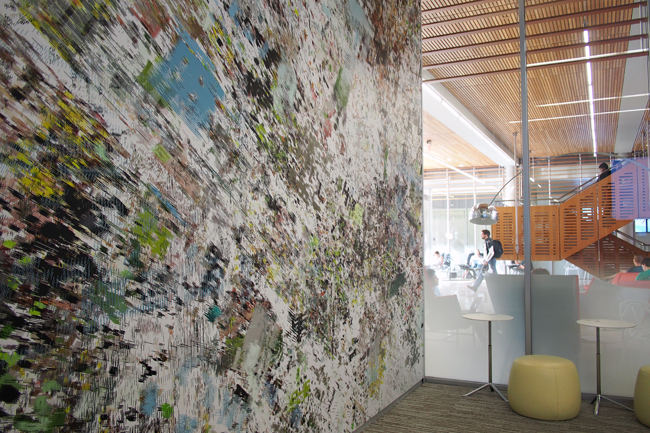Casey Reas, a digital media artist and professor at the University of California, Los Angeles, can paint a picture with technology.
His unorthodox medium is what brought his two-part wall mural, “A Mathematical Theory of Communication,” to the Gates Dell Complex on campus as a permanent installation. The piece will be unveiled Friday afternoon, featuring a Q-and-A with Reas, followed by a reception.
The piece was commissioned through a partnership between Landmarks, the University’s public art program, and the computer science department. Reas made a point to visit the University before finalizing his installment.
“A lot of the piece came out of my visit to campus earlier in the year,” Reas said. “My work for many years has worked with ideas of emergence and information theory, and it became a hybrid between ideas I had been working with, along with the research that is going on in the building by the different faculty.”
Reas took an original source material, communication media such as television waves and radio waves, and gradually broke down their codes until they appeared to be abstract.
“I start with a series of images, like a collage,” Reas said. “Then I write some software to break them down and reassemble them into a new form, and, in the case of this piece, that new form is printed. Even though it looks largely abstract, the origin of this piece is in a very representational photographic image.”
In collaboration with Landmarks, the computer science department was searching for a piece to complement the existing grid-like, structured art installations in the building. Artist Sol LeWitt’s sculpture installation, “Circle with Towers,” sits in front of the Gates Dell Complex.
“LeWitt was creating the instructions and using people to construct the work,” said Nickolas Nobel, the Landmarks external affairs coordinator. “Casey Reas is using the computer in order to create the design for the work and then using the computer itself to construct the work.”
Once Reas had the rendered image, the work was printed by inkjet printers onto a material similar to wallpaper.
“The GDC feels very modern, and that contrasts it pretty hard,” computer science junior Robert Lynch said. “Something like the Sol LeWitt painting behind the elevators has vivid colors and sharp angles, which complement the building’s shape, which is why I like it.”
Nobel said much consideration went into the placement of Reas’ piece.
“The work is there to complement and be a response to its own location,” Nobel said. “This is particularly true with Casey Reas’ work, where he is synthesizing technology and art.”
The piece was largely inspired by the book “The Mathematical Theory of Communication,” by Claude Shannon, and Shannon’s views on information theory, according to Reas.
“I’m really interested in the fundamental elements in a metaphorical sense of patterns,” Reas said. “This piece is all about images and mass communication and about how images are taken apart and analyzed and put back together again, or how they are pressed and decompressed.”
Reas said the biggest misconception about his work is that the computers make all the decisions for him.
“It’s a very traditional way of working in the studio,” Reas said. “It feels like there’s this potential that is unexplored, and there is just this joy of making things and seeing them.”















